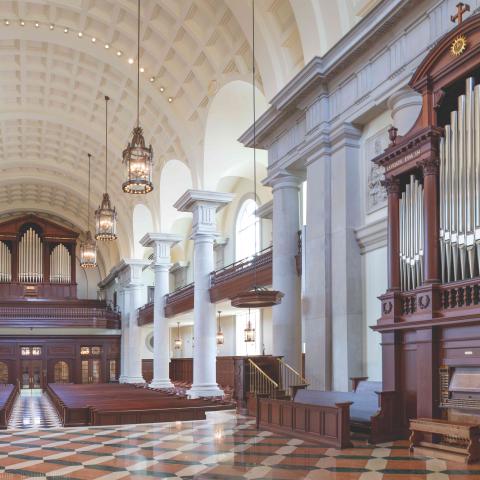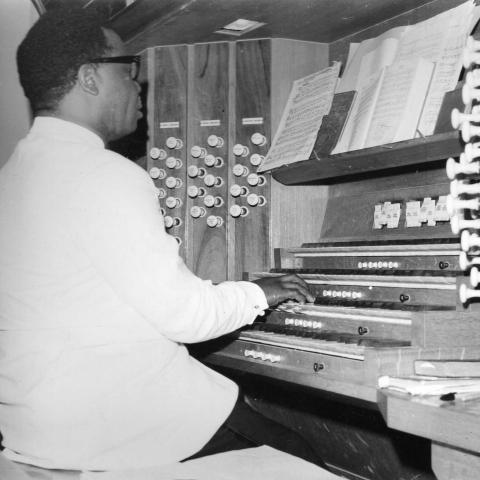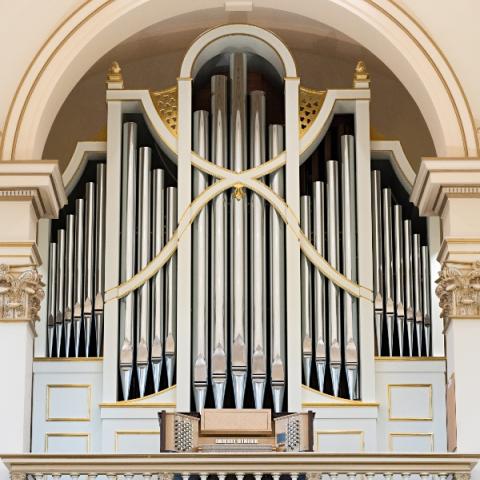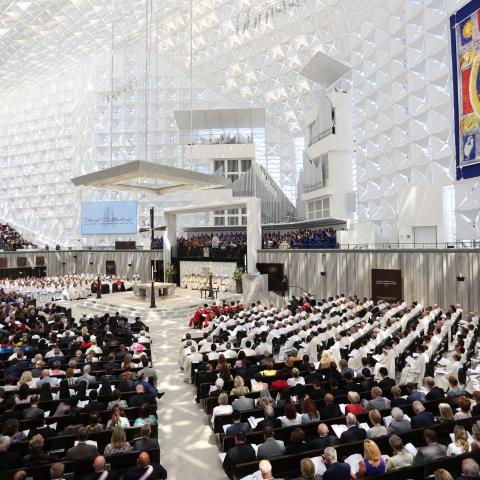Michał Szostak, Polish organist, researcher, and author, completed a doctorate degree in organ performance in February 2019. He studied organ performance at the Fryderyk Chopin University of Music in Warsaw with Andrzej Chorosiński, as well as organ improvisation at the Pontificio Istituto Ambrosiano di Musica Sacra in Milan with Davide Paleari. He regularly performs organ recitals in Denmark, France, Germany, Great Britain, Italy, Poland, Russia, Ukraine, and the United States, and has recorded three CDs. His organological research is regularly published by Polish and international organ magazines. From 2011–2018 he was the music director and principal organist of the Basilica in Licheń Stary. For further information: www.michalszostak.org.
Between 2002 and 2007, in Licheń Stary, near the geographical center of Poland, the Polish organbuilder Zakłady Organowe Zych built a monumental instrument of 157 stops. Designed by Andrzej Chorosiński, the instrument is now the largest organ in Poland and is controlled by a six-manual console.
Licheń Stary has a population of approximately 1,500 people. After World War II, priests of the order of the Marian Fathers promoted the devotion to the Blessed Virgin Mary here, centered around a small seventeenth-century oil painting of the Blessed Virgin. The ever-increasing number of pilgrims visiting the village could not be accommodated in the small local church housing the painting.
The Marian Fathers decided to build a new and larger church for the painting and pilgrims, an edifice that would become a minor basilica and consequently the largest church edifice in Poland. Construction began in 1992, and Pope Saint John Paul II blessed the building in 1999, though construction continued into 2002. The size of the basilica is 3,237,000 cubic feet, and the usable area is 247,600 square feet. The length of the nave is approximately 456 feet, while the width of the transept with uneven shoulder lengths is approximately 472 feet.1 With the completion of construction there was a need to equip the interior with liturgical elements, including a pipe organ.
The motivator of the pipe organ project was Reverend Eugeniusz Makulski, MIC, a great lover of organ music and the person most responsible for the construction of the shrine. In mid-2002, when construction of the basilica was nearly complete, Father Makulski finalized the plans that would lead to the construction of a pipe organ to adorn the monumental interior. He decided the organ must be exceptional and worthy of the largest church in Poland; it would have at least 100 stops with a beautiful and noble sound and visual appearance. The other stipulation was that at least some of the instrument had to be playable by June 14, 2003.2
After analyzing various organbuilders’ bids, the Marian Fathers entrusted the project to the firm of Zakłady Organowe Zych. The signing of the contract for the construction of the first part of the organ, the instrument for the west gallery, took place on August 21, 2002.
The organ firm, headed by Dariusz Zych, had to rely on acoustical plans for the instrument concept to avoid disappointments and surprises at the final stage of this work. The starting point for the development of the whole specification by Andrzej Chorosiński was the unrealized project by Aristide Cavaillé-Coll for Saint Peter’s Basilica, Vatican City.3 Based on the measured analysis of the acoustic parameters of the basilica, Chorosiński began to develop the specification of the organ and the composition of stops. The fact that the Licheń Basilica has five galleries (one in the main nave, two in the west and east aisles, and two galleries in the sanctuary), gave rise to the concept of creating a spatial sound unit composed of five elements. The great organ of the basilica has been placed in the southern, western, and eastern parts of the church. The project was completed with two Chancel Positives on two small balconies at both presbytery gables, where the apse connects to the main nave. The scales of the stops, as well as the compositions of composite stops (mixtures, etc.), were individually developed by Chorosiński.
Zakłady Organowe Zych accomplished all design work, construction of organ cases, windchests, key and stop actions, wooden ranks and wooden resonators of reeds, as well as assembly of all elements, voicing, and tuning. Subcontractor companies that were commissioned to carry out specific assignments included: KOART Krzysztof Cieplak (structures made of stainless steel), Otto Heuss GmbH from Lich, Germany (consoles, electronics, Zimbelstern, tubular bells), Aug. Laukhuff GmbH & Co. KG from Weikersheim, Germany (West Organ façade pipes), Jacques Stinkens
Orgelpijpenmakers BV from Zeist, the Netherlands (façade pipes for the South Organ), Süddeutsche Orgelpfeifenfabrik Roland Killinger GmbH from Freiberg on the River Neckar, Germany (reeds for West Organ, East and West Positives), Orguian Lda. from Avidos, Portugal (reeds for the South Organ), and Ryszard Chacinski from Kobylka near Warsaw (metal labial stops). Decorative elements adorning the organ cases were carved in wood by Janusz Regulski and Tomasz Kusnierz from Sochaczew near Warsaw, and then gilded in the goldsmith’s workshop of Henryk Kwiatkowski from Poznań.
All assembly, voicing, and tuning were completed before July 2, 2006, so that during the solemn Mass that day, when the famous painting of Our Lady of Licheń was introduced to the basilica, a fully prepared instrument could be heard. Thousands of pilgrims from all over the world took part in the ceremony of transferring the image to its new home.
One month later, on August 1, 2006, there was a technical and artistic reception of the completed organ made by a commission consisting of representatives of the Marian Fathers, organbuilders, organists, and musicologists, who were all very pleased with the work. The acceptance protocol was signed by members of the commission composed of Rev. Wiktor Gumienny, MIC, Father Superior of the Licheń Shrine; Professor Urlich Grosser, German conductor and organist; Professor Roberto Padoin, organist and professor at the Conservatory B. Marcello in Venice; Reverend Dr. Jacek Paczkowski, chairman of the church music committee of the Diocese of Kalisz; Reverend Dr. Mariusz Klimek, director of the Church Music Study of the Diocese of Torun; Siegfried Sauer, organbuilder from Germany; Adam Klarecki, organist of the Wloclawek cathedral; Jacek Łukasik and Robert Grudzien, organists; and Jaroslaw Adamiak, then organist of the Licheń Shrine. Artistic decoration of the cases took nearly another year, and the dedication of the organ took place on the first anniversary of the transfer to the basilica of the famous painting of Our Lady of Licheń on July 2, 2007, during a Mass celebrated by Bishop Wieslaw Alojzy Mering.
Description of the organ
The organ of the Basilica of Our Lady of Licheń comprises 157 stops, 12,323 pipes, and five “organs” (in the chronology of construction): the West Organ, the South Organ (located in three organ cases on the same gallery above the main entrance), the East Organ, the East Chancel Positive, and the West Chancel Positive. The South Organ and the West Organ are fully independent instruments and have their own consoles. The East Organ and both Chancel Positives do not have their own consoles and can be played only from the main console. An organist playing from the main console has eleven independent divisions from which to choose. The key action is mechanical-electric, while the stop action is electric; windchests are slider and pallet, and the alloys of pipe metals contain tin up to 85–90%. All divisions of the instrument have a manual compass of C–c4 and pedal compass of C–g1. The layout of all parts of the organ throughout the basilica is presented in Figure 1.
The South Organ
The core of the whole organ of the Licheń Basilica is the South Organ, which contains the principal divisions of the instrument. The South Organ is the second in chronological order of construction, built between mid-2003 and 2005. This eighty-one-stop instrument with four manuals has a typical sound arrangement for the nineteenth-century French Romantic period: Grand-Orgue, Positif, Récit-expressif, and Pédale. In addition there is a high-pressure Solo division placed on Manual IV. In each division one finds a full set of basic stops (Jeux de Fonds) in the form of principals, flutes, and strings, as well as stops—according to Aristide Cavaillé-Coll’s nomenclature—available (Jeux de Combinaisons) in the form of mutations, mixtures, cornets, and reeds.
The console is placed centrally in the organ case and on a multi-stage elevation. Registers are placed on either side of the keydesk: on the left side for the Pédale and Grand-Orgue, on the right side for the Positif, Récit-expressif, and the Solo division. The stop action is electric, while the key action is mechanical (for the majority of the Grand-Orgue, Positif, Récit-expressif, and Pédale windchests) and electric (for the entire Solo division, as well as selected portions of the Grand-Orgue, Positif, Récit-expressif, Pédale windchests, and double pallets for bass notes). The Récit-expressif section is enclosed in a swell box controlled by a balanced shoe with electric action; next to the expression shoe is a crescendo roller, which allows seamless dynamic changes. The player sits with his back to the main altar, and the console has a solid-state combination action system with an extensive storage capacity.
The South Organ consists of three separate organ cases placed on the same gallery on the axes of the main and side naves and is anchored on a twenty-ton steel structure. Architecturally, the cases are inspired by the organ case built between 1999 and 2003 by Schoenstein & Co. for the Conference Center in Salt Lake City, Utah, in the United States. A great majority of the façade pipes are speaking pipes. The main case contains the Grand-Orgue, Positif, Récit-expressif, Solo, and most of the Pédale division. In the side cases there are windchests for several Pédale stops (divided on C and C-sharp sides).
Each side case has its own small blower and a separate wind system. The wind system of the main South Organ’s section is fed by three electric blowers: the first blower feeds the Grand-Orgue, Positif, and Pédale, the second feeds the Récit-expressif, and the third feeds the high-pressure Solo division.
The South Organ contains the tallest open wood pipes of the whole organ, which belong to the Pédale 32′ Subcontrabasse, a principal stop. In this section there is also a second 32′ stop, the Contrabombard, the tallest reed resonators in the organ. The instrument also contains the largest tin pipes of the Licheń organ, located in the central organ case. The largest has a length of 25-1⁄2 feet, a diameter of one foot, and weighs 330 pounds.
The West Organ
The West Organ, placed on the gallery above the left transept of the basilica above the Pieta Porch, was built between August 2002 and June 2003. This two-manual instrument includes 51 stops enhanced with Zimbelstern and Tympan imitating the sound of a storm (Pédale d’Orage). Registers are placed at either side of the keydesk: on the left for the Pedal and the Hauptwerk sections, on the right side for the Schwellwerk division and additional devices. The instrument contains both mechanical and electric-action chests, double pallets for low keys, and electric stop action. All couplers are electric. As in the South Organ, the Schwellwerk is enclosed in a box managed by a balanced expression shoe with electric action, in addition to a crescendo roller. The console, slightly elevated, is centrally integrated into the organ case. The player sits with his back to the main altar, and the console features an extensive solid-state combination action.
The specification of the West Organ is slightly non-standard, divided between two manuals and pedal. Initially, it was planned that this instrument would have three manuals, however, due to the constraints imposed by basilica architect, Barbara Bielecka, on the dimensions of the organ case, it was decided to limit the number of manual divisions while maintaining a wealth of stops. In each section there is a full range of principals (in the Hauptwerk based at 16′, in the Schwellwerk at 8′, in the Pedal at 16′), enriched with flute stops of all types, strings, and reeds. In the Pedal section there is one 32′ stop, a stopped wood Bourdon. All divisions have mutation stops (2-2⁄3′, 1-3⁄5′, 1-1⁄3′, 8⁄9′) and at least one mixture (in the Hauptwerk there are two mixtures and a cornet). This instrument was conceived for performing Baroque pieces; however, thanks to a large number of foundation stops (as many as eleven manual stops, i.e., 30%, are at 8′), Romantic and symphonic pieces also work well. In the West Organ are also placed tubular bells with a compass from g to g2.
The placement of pipe flats in the organ case reflects the arrangement of the divisions inside the instrument. In the central part of the case (three double flats, each crowned with a group of small pipes) we see the Hauptwerk, the Schwellwerk above it (another three double flats, each crowned with a group of small pipes, the wooden shutters of the swell box located just behind the façade), and two symmetrical pedal towers—left side C, right side C-sharp. The façade pipes belong to the 16′ Principal from the Hauptwerk and the independent 16′ Principal from the Pedal. The organ weighs a total of thirty tons.
The blessing and dedication of the West Organ took place on June 14, 2003, by Bishop Roman Andrzejewski, while the inaugural concert was performed by Andrzej Chorosiński. The event, which was very popular with the media, attracted many outstanding guests from around the world.
The East Organ
The East Organ, built between September 2005 and 2006, is housed in twin towers with trapezoidal bases placed between high windows on the east gallery, which crowns the right transept of the basilica over the Four Evangelists’ Porch. The instrument has eight stops; the key and stop action are electric, and the windchests are slider and pallet. Looking from the center of the basilica, the left tower contains two windchests, placed one above the other, with C side pipes, while the right tower is similar with C-sharp side pipes.
The external structure of the organ cases reflects the internal arrangement of windchests for flue pipes. Each case has two main pipe flats separated by horizontal resonators of the Trumpets (16′, 8′, and 4′) and one small set of pipes at the very top, which are dummy pipes. Both towers are supplied by one blower that is placed in the left tower; the channel supplying air to the right tower runs along the gallery floor. The whole instrument is supplied with air under high pressure. As a result of this treatment, the volume of the eight stops of the East Organ is equivalent to the sound of fifty-one stops along with the super-octave couplers of the West Organ. This instrument can only be played from the main console and may be assigned to any of the six keyboards and pedalboard.
The West Chancel Positive
Built in 2006, the West Chancel Positive, with seven stops (plus Nachtigall), has electric key and stop action. Everything, including the blower, is enclosed in a single case, a mirror image of the East Chancel Positive. This instrument does not have a separate console, but rather is played from the main console only, as a floating division. This section, richly equipped with string stops, perfectly matches the ethereal voices of the Récit-expressif section of the South Organ. With proper registration, it surrounds the listener with the impression of “heavenly voices” (Vox Coelestis).
The East Chancel Positive
The East Chancel Positive was completed in 2006 and features eight stops constructed with early Baroque scaling and electric key and stop action. The whole instrument is enclosed in a single case like the West Chancel Positive. This division also does not have a separate console, but is a floating division of the main console. The disposition of this instrument was inspired by early Baroque Flemish organs and pairs well with the West Organ. With proper registration and manual changes, the East Chancel Positive and the West Organ can produce dialogue effects, concertino and tutti, in a manner characteristic of instrumental concertos of the Baroque era.
Where are the largest pipe organs in Europe?
On the basis of the criterion of organ classification in terms of size (i.e., number of ranks and auxiliary devices managed from one console) published by the author in 2017 in Polish4 and English5 literature on the subject, the organ of the Basilica of Our Lady of Licheń is the largest instrument in Poland, the fourth largest in Europe, and the thirteenth largest in the world. Among ecclesiastical organs, it is the tenth largest instrument and has one of the largest consoles in the world. The console of the Licheń organ is also the largest console among Polish organs and is one of the largest consoles in Europe.
The organist playing from the main console has a total of eleven fully independent divisions: nine manual divisions and two pedal divisions. Most divisions can be assigned at will on the six manuals and pedalboard, allowing ultimate flexibility.
The monumental main console is located in the sanctuary of the basilica. The lowest manual keyboard has the deepest key movement, while the top keyboard, the shallowest. The manual keyboards, moving from the lowest to the highest, are inclined at increasing angles. The main console is connected to all sections by a wired computer network and MIDI system. For each of the main console’s keyboards and pedalboard, it is possible to assign each section of the West Organ, the East Organ, the West Chancel Positive, the East Chancel Positive, and Manual IV of the South Organ. The Grand-Orgue, Positif, Récit-expressif, and Pédale from the South Organ can be assigned only to manuals I, II, III, and pedalboard on the main console (plus standard section couplers within the South Organ).
The console is equipped with two balanced expression pedals to control two swell boxes (right, Schwellwerk of the West Organ; left, Récit-expressif of the South Organ). On the left side of the expressive pedals, there is a crescendo roller with two pre-programmed crescendos (smooth or stepwise). The console is equipped with a separate solid-state memory system; it has a cut-out switch for all reeds, as well as Tutti and General Tutti switches and General Cancel. The console was made in the workshop of Otto Heuss GmbH and is a work of art.
Conclusion
The course of history is surprising when considering a proposal for a project in 1875 by one of the greatest organbuilders of all times intended for the largest Catholic church in the world inspires the creation of a new organ 130 years later in the largest basilica of Poland, a country that did not even exist on the maps of Europe when Aristide Cavaillé-Coll lived. Though Cavaillé-Coll invited many great personalities from the world of politics, the Vatican authorities did not manage to materialize the project at Saint Peter’s Basilica; yet a priest in a relatively poor country with the support of countless pilgrims offering their small donations for this purpose did. Really, history can be amazing!
Several compact discs of organ music have been recorded so far on the organ of the Licheń Basilica. In 2003, Andrzej Chorosiński recorded organ literature, which was the first recording of the West Organ. In 2007, a Belgian organist of Polish descent, Karol Golebiowski, recorded a second album with the entire organ. In September 2017 the author recorded the third album, Ave Regina Caelorum, including improvisations on Gregorian and Polish Marian themes in two Romantic cyclic forms: organ symphony and symphonic poem on the South Organ. In June 2018 he recorded the fourth album, French Inspirations: the Second Half of the 19th Century, including literature of Franck, Lefébure-Wély, Lemmens, Guilmant, and an improvised five-movement organ symphony. (These last two discs can be found on eBay.)
I cordially invite you to Licheń Stary, where one can hear and see the largest organ in the largest ecclesiastical interior of Poland.
Notes
1. Krzysztof Jedrzejewski, Przewodnik po Sanktuarium Lichenskimm (Licheń Stary, Zaklad Gospodarczy “Dom Pielgrzyma,” 2014), p. 181.
2. Organy Licheński (Licheń Stary, Zaklad Gospodarczy “Dom Pielgrzyma,” 2007), p. 22.
3. For more information on this organ proposal, see Ronald Ebrecht’s book, Cavaillé-Coll’s Monumental Organ Project for Saint Peter’s, Rome: Bigger than Them All (Lanham, Maryland, Lexington Books, 2011).
4. Michal Szostak, “Wielkie organy Bazyliki w Licheniu w zestawieniu z najwiekszymi organami swiata,” Wokol nowych organow w kosciele NSPJ w Tarnowie, ed. Pawl Pasternak (Tarnów, Poland, Biblos, 2017, ISBN 978-83-7793-504-0), and Michal Szostak, Lichenskie organy na tle najwiekszych instrumentow Polski, Europy i swiata (Licheń Stary, Zaklad Gospodarczy “Dom Pielgrzyma,” 2017, ISBN 978-83-64126-14-7).
5. Michal Szostak, “The World’s Largest Organs,” The Organ, No. 382, November 2017–January 2018, ISSN 0030-4883, pp. 12–28.
Specification of the organ:
South Organ
GRAND-ORGUE (Manual I)
16′ Montre
16′ Bourdon
8′ Montre
8′ Flûte Harmonique
8′ Gamba
8′ Kopula
8′ Dolce
5-1⁄3′ Quinte
4′ Prestant
4′ Flute
4′ Salicet
2-2⁄3′ Quinte
2′ Doublette
1-3⁄5′ Tierce
IV Gr. Fourniture
IV Mixtur
V Gr. Cymbel
IV Cymbel
16′ Bombarde
16′ Fagot
8′ Trompet
8′ Hautbois
4′ Clairon
IV–I
III–I
II–I
POSITIF (Manual II)
16′ Violon
8′ Diapason
8′ Flûte Harmonique
8′ Salicional
4′ Prestant
4′ Flûte
4′ Viole
2-2⁄3′ Quinte
2′ Piccolo
III Sesquialtera
V Plein Jeu
III Scharf
16′ Dulcjan
8′ Cromorne
8′ Clarinette
8′ Jannhorn
Tremolo
IV–II
III–II
Recit-expressif (Manual III, enclosed)
16′ Bourdon
8′ Montre
8′ Flûte Traversiere
8′ Rurflet
8′ Gamba
8′ Voix Celeste
4′ Prestant
4′ Flûte Traversiere
4′ Viola
2-2⁄3′ Nazard
2′ Doublette
V Cornet
IV–V Fourniture
16′ Basson
8′ Trompet
8′ Hautbois
8′ Vox Humana
4′ Clairon Harm.
Tremolo
IV–III
SOLO (Manual IV, enclosed)
8′ Flauto Major
8′ Gamba
8′ Keraulophon
V Cornet
8′ Tuba Mirabilis
Pedale
32′ Subcontrabasse
16′ Contrabasse
16′ Violonbasse
16′ Subbass
10-2⁄3′ Quintbass
8′ Octavbass
8′ Flûte
8′ Flûtebass
8′ Cello
4′ Choral
2′ Ocarina
III Sesquialtera
V Hintersatz
IV Mixtur
32′ Contrabombard
16′ Bombard
10-2⁄3′ Quinttrompet
8′ Trompet
4′ Clairon
IV–P
III–P
II–P
I–P
West Organ
HAUPTWERK (Manual I)
16′ Prinzipal
8′ Octave
8′ Holzflöte
8′ Bourdon
8′ Gamba
8′ Gemshorn
4′ Oktave
4′ Szpicflet
4′ Viola
2-2⁄3′ Quinte
2′ Superoctave
1′ Flageolet
V Cornet
V Mixtur
IV Mixtur
16′ Trompet
8′ Trompet
4′ Trompet
II–I
Super I
SCHWELLWERK (Manual II, enclosed)
16′ Quintadena
8′ Prinzipal
8′ Rohrflöte
8′ Salicet
4′ Prestant
4′ Traversflöte
4′ Gemshorn
2-2⁄3′ Nazard
2′ Oktave
2′ Piccolo
1-3⁄5′ Terz
1-1⁄3′ Larigot
8⁄9′ None
V Scharf
16′ Dulcian
8′ Krummhorn
8′ Clarinette
Tremolo
Tubular Bells
PEDAL
32′ Bourdon
16′ Prinzipal
16′ Subbass
16′ Violonbass
8′ Oktavbass
8′ Fletbass
8′ Cello
4′ Choral
4′ Bourdon
II Sesquialtera
IV Mixtur
16′ Bombard
16′ Fagott
8′ Trompet
4′ Clairon
II–P
Super I–P
I–P
Zimbelstern
Tympan
East Organ
8′ Diapason
8′ Gedeckt
4′ Prestant
2′ Oktave
III–IV Cymbel
16′ Tuba Magna
8′ Tuba Mirabilis
4′ Clairon
West Chancel Positive
8′ Vox Humana (labial, 2 ranks)
8′ Gamba
8′ Aeolina
8′ Vox coelestis
4′ Prinzipal
4′ Fugara
III Harmonia Aeth.
Nachtigall (nightingale)
Tremolo
East Chancel Positive
8′ Gedeckt
4′ Prinzipal
4′ Hohlfloete
4′ Quintade
2′ Dezchen
III Zimbel
8′ Regal
4′ Zink
Tremolo






